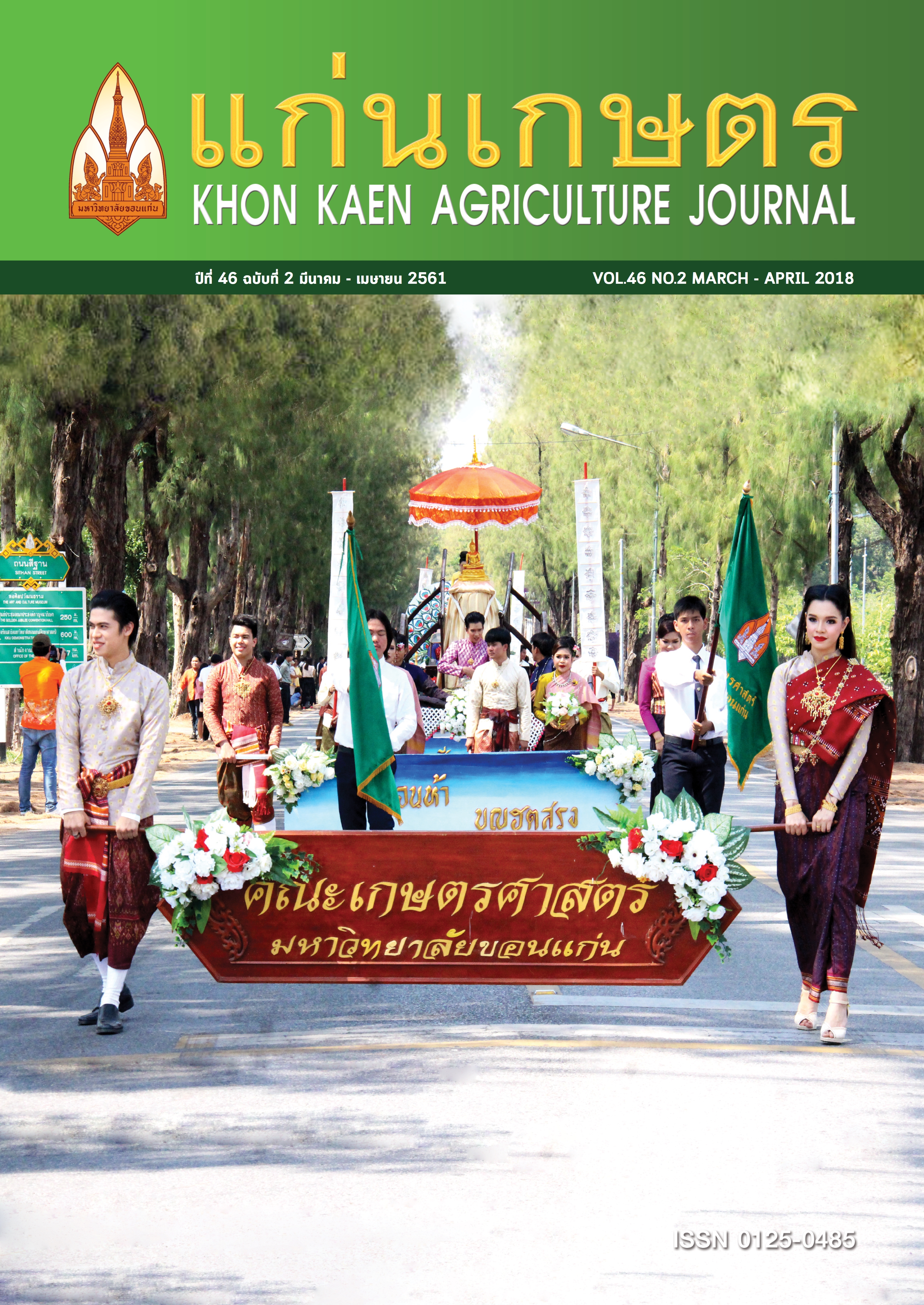การกักเก็บคาร์บอนอินทรีย์และไนโตรเจนรวมในดินนาบริเวณที่ราบลุ่มภาคกลางของประเทศไทย
Main Article Content
บทคัดย่อ
การกักเก็บคาร์บอนอินทรีย์และไนโตรเจนรวมในดินเป็นกระบวนการที่มีความสำคัญอย่างมากต่อวิกฤตการณ์ภาวะโลกร้อน อีกทั้งยังมีความสำคัญต่อการส่งเสริมผลิตภาพของดินและความยั่งยืนในการใช้ประโยชน์ที่ดิน การศึกษานี้มีวัตถุประสงค์เพื่อศึกษาปริมาณการกักเก็บคาร์บอนอินทรีย์และไนโตรเจนรวมในดินนาบริเวณที่ราบลุ่มภาคกลางของประเทศไทย โดยคัดเลือกตัวแทนดินนาที่มีพัฒนาการทางดินแตกต่างกัน ได้แก่ ดินในอันดับอินเซปทิซอลส์ จำนวน 3 ชุดดิน ดินในอันดับแอลฟิซอลส์ จำนวน 3 ชุดดิน และดินในอันดับอัลทิซอลส์ จำนวน 2 ชุดดิน ศึกษาสัณฐานวิทยาสนามของดิน และเก็บตัวอย่างดินตามชั้นการกำเนิดดินมาวิเคราะห์ปริมาณคาร์บอนอินทรีย์และไนโตรเจนรวมในดินและในอนุภาคของดินแต่ละขนาด ผลการศึกษาพบว่า ดินแต่ละอันดับมีปริมาณการกักเก็บคาร์บอนอินทรีย์และไนโตรเจนรวมในชั้นไถพรวนแตกต่างกันอย่างมีนัยสำคัญทางสถิติ โดยดินในอันดับอินเซปทิซอลส์มีปริมาณการกักเก็บคาร์บอนอินทรีย์และไนโตรเจนรวมสูงที่สุด รองลงมาเป็นดินในอันดับแอลฟิซอลส์ และอัลทิซอลส์ ตามลำดับ ดินทุกอันดับมีสัดส่วนสัมพัทธ์ของปริมาณคาร์บอนอินทรีย์ทั้งหมดและไนโตรเจนรวมทั้งหมดในอนุภาคขนาดดินเหนียว > อนุภาคขนาดทรายแป้ ง > อนุภาคขนาดทราย ตามลำดับ ปริมาณคาร์บอนอินทรีย์และไนโตรเจนรวมในดิน และในอนุภาคของดินแต่ละขนาดมีสหสัมพันธ์เชิงลบกับความสูงจากระดับทะเลปานกลาง ค่าสีดิน และค่ารงค์ของดินที่ทำการศึกษาอย่างมีนัยสำคัญทางสถิติ
Article Details
เอกสารอ้างอิง
เอิบ เขียวรื่นรมณ์. 2533. ดินของประเทศไทย. ลักษณะ การแจกกระจาย และการใช้. ภาควิชาปฐพีวิทยา คณะเกษตร มหาวิทยาลัยเกษตรศาสตร์, กรุงเทพฯ.
Batjes, N. H. 1996. Total carbon and nitrogen in the soils of the world. Eur. J. Soil Sci. 47: 151-163.
Buol, S. W., R. J. Southard, R. C. Graham, and P. A. McDaniel. 2011. Soil genesis and classification. 6th Edition. Wiley-Blackwell, Chichester.
Christensen, B. T. 1992. Physical fractionation of soil and organic organic matter in primary particle size and density separates. Adv. Soil Sci. 20: 1-90.
Diekow, J., J. Mielniczuk, H. Knicker, C. Bayer, D. P. Dick, and I. Kögel-Knabner. 2005. Carbon and nitrogen stocks in physical fractions of a subtropical Acrisol as influenced by long-term no-till cropping systems and N fertilization. Plant Soil. 268: 319-328.
Doetterl, S., A. A. Berhe, E. Nadeu, Z. Wang, M. Sommer, and P. Fiener. 2016. Erosion, deposition and soil carbon: A review of process-level controls, experimental tools and models to address C cycling in dynamic landscapes. Earth-Sci. Rev. 154: 102-122.
Eswaran, H., E. van den Berg, and P. F. Reich. 1993. Organic carbon in soils of the world. Soil Sci. Soc. Am. J. 57: 193-194
Feller, C., and M. H. Beare. 1997. Physical control of soil organic matter dynamics in the tropics. Geoderma. 79: 69-116.
Gee, G. W., and J. W. Bauder. 1986. Particle-size analysis. P. 383-411. In: A. Klute. Methods of Soil Analysis, Part I. Physical and Mineralogical Methods. Am. Soc. Agron. Inc., Madison, WI. Harrison-Kirk, T., M. H. Beare, E. D. Meenken, and L. M. Condron. 2014. Soil organic matter and texture affect responses to dry/wet cycles: Changes in soil organic matter fractions and relationships with C and N mineralisation. Soil Biol. Biochem. 74: 50-60.
Hassink, J. 1997. The capacity of soils to preserve organic C and N by their association with clay and silt particles. Plant Soil. 191: 77-87.
Karchegani, P. M., S. Ayoubi, M. R. Mosaddeghi, and N. Honarjoo. 2012. Soil organic carbon pools in particle-size fractions as affected by slope gradient and land use change in hilly regions, western Iran. J. Mt. Sci. 9: 87-95.
Konen, M. E., C. L. Burras, and J. A. Sandor. 2003. Organic carbon, texture, and quantitative color measurement relationships for cultivated soils in North Central Iowa. Soil Sci. Soc. Am. J. 67: 1823-1830.
Lorenz, K., and R. Lal. 2005. The depth distribution of soil organic carbon in relation to land use and management and the potential of carbon sequestration in subsoil horizons. Adv. Agron. 88: 35-66.
Moritsuka, N., K. Matsuoka , K. Katsura, S. Sano, and J. Yanai. 2014. Soil color analysis for statistically estimating total carbon, total nitrogen and active iron contents in Japanese agricultural soils. Soil Sci. Plant Nutr. 60: 475-485
National Soil Survey Center. 1996. Soil Survey Laboratory Methods Manual. Soil Survey Investigations Report No. 42, Version 3.0. Natural Conservation Service, USDA.
Nelson, D. W., and L. E. Sommers. 1996. Total carbon, organic carbon, and organic matter. pp. 539-579. In: A. L. Page, R. H. Miller, and D. R. Keeney. Methods of Soil Analysis, Part II: Chemical and Microbiological Methods Properties. Am. Soc. Agron. Inc., Madison, WI.
Rumpel, C., and I. Kögel-Knabner. 2011. Deep soil organic matter-a key but poorly understood component of terrestrial C cycle. Plant Soil. 338: 143-158.
Six, J., K. Paustian, E. T. Elliott, and C. Combrink. 2000. Soil structure and organic matter: I. Distribution of aggregate-size classes and aggregate-associated carbon. Soil Sci. Soc. Am. J. 64: 681-689.
Soil Survey Staff. 2014. Keys to Soil Taxonomy. 12th edition. USDA–Natural Resources Conservation Service. Washington, DC. Sørensen, L. H. 1974. Rate of decomposition of organic matter in soil as influenced by repeated air drying-rewetting and repeated additions of organic material. Soil Biol. Biochem. 6: 287-292.
Veldkamp, E. 1994. Organic carbon turnover in three tropical soils under pasture after deforestation. Soil Sci. Soc. Am. J. 58: 175-180.
Zinn, Y. L., R. Lal, J. M. Bigham, and D. V. Resck. 2007. Edaphic controls on soil organic carbon retention in the Brazilian Cerrado: texture and mineralogy. Soil Sci. Soc. Am. J. 71: 1204-1214.


